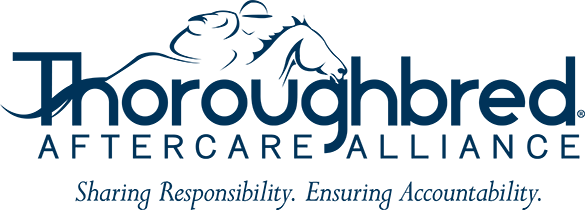Code of Standards
It is the responsibility of all participants in the Thoroughbred industry to ensure the humane care of horses when their racing careers are over.
To that end, the Thoroughbred Aftercare Alliance has established an accreditation program for aftercare organizations that handle Thoroughbred racehorses as a part of their core competencies, recognizing that the Thoroughbred is a unique breed and requires specialized knowledge and skills for their care. Organizations wishing to be accredited by Thoroughbred Aftercare Alliance must complete a Thoroughbred Aftercare Alliance Accreditation Application, must meet Thoroughbred Aftercare Alliance’s Code of Standards, and must agree to both scheduled and random site inspections as part of the Accreditation process. Initially, organizations will be re-accredited every other year, with intervening random inspections to ensure that the Code of Standards is consistently upheld. Organizations may be accredited by Thoroughbred Aftercare Alliance or a nationally recognized sanctioning body in the horse industry that is approved by Thoroughbred Aftercare Alliance in lieu of its own accreditation. In the latter case, Thoroughbred Aftercare Alliance reserves the right to conduct its own site inspections.
Thoroughbred Aftercare Alliance recognizes that the formal field and body of knowledge for the operation of aftercare organizations are fluid and growing. Furthermore, Thoroughbred Aftercare Alliance recognizes that aftercare organizations are constantly improving to optimize their care of Thoroughbreds. Thoroughbred Aftercare Alliance in partnership with providers and supporters intends to offer consultation to aftercare organizations in their efforts to improve and to bring innovative practices to all providers. As “best practices” emerge and change for aftercare, so too will Thoroughbred Aftercare Alliance’s Code of Standards.
The Thoroughbred Aftercare Alliance Code of Standards covers the following areas:
- Operations
- Education
- Horse health care management
- Facility standards and services
- Adoption policies and protocols
Standards for each of the five areas that comprise the Code of Standards appear below.
Governance and program operations are the foundation of any Thoroughbred aftercare organization. Accredited organizations must demonstrate operational stability; financial transparency; sound and ethical business practices; responsible use of resources; and adherence to applicable federal, state and local laws and regulations. Accredited organizations shall provide evidence of:
- Federal not-for profit status as a 501 (c)(3). Organizations must be in good standing with the IRS and the state of incorporation and be registered to solicit charitable contributions. Organizations must have been in operation for at least three years and be able to provide detailed financial and operational records.
- The organization’s governing authority and program structure, including corporate/legal formation, organizational by-laws and operational overview. The organization shall have a board of directors that meets regularly and make available the minutes of all board meetings upon request.
- Proof of facility/land ownership or a copy of a current leasing or boarding agreement for all applicable facilities used or owned by the organization.
- Up-to-date insurances, licenses, and permits required by law, including directors and officers (D&O) insurance.
- Compliance with generally accepted accounting principles, copy of the most recently filed Form 990 (or applicable IRS filings, such as 990EZ), completed Statement of Functional Expenses corresponding with most recently filed 990, and profit and loss statements and balance sheet for current and prior year.
- Generally accepted banking procedures, including proof of a business checking account; protocols for check signing; and procedures for fund management, reporting and handling of contributions in accordance with IRS regulations.
- Loan repayment schedules if applicable.
- Conformance with generally accepted principles for fund raising and documentation of fund raising expenses and revenues.
- A sufficient number of qualified employees and/or volunteers in place to ensure proper running of the program’s administrative and horse care operations. Programs should aim to provide continuing education and training for all managerial, administrative and equine care staff members.
How aftercare organizations educate the public, media, regulators, community officials, law enforcement personnel, legislators, regulators and others about humane aftercare of Thoroughbreds greatly affects not only the aftercare community itself but the Thoroughbred racing industry as a whole. Whenever possible, accredited organizations should work cooperatively with the Thoroughbred racing community to share media resources and increase public awareness of Thoroughbred aftercare to uphold the image and integrity of the horseracing industry. Accredited organizations shall:
- Use best efforts to promote humane Thoroughbred aftercare through educational programs. Examples of educational programs include training demonstrations or seminars, having a booth at a racetrack or expo, or involvement with equine or youth programs such as Pony Clubs, 4-H, Scouts, and college groups.
- Provide basic marketing for their organizations and the horses in their care. Marketing may include website, television, radio, online, social media or print media.
- Portray all media via press release, Internet, articles, or interviews with a positive outlook on Thoroughbred aftercare and the racing industry.
- Each facility should have one spokesperson who communicates with media with specific talking points concerning the racing industry and other issues the media may raise.
All facilities used by the organization, including foster farms, shall provide the necessary care needed to ensure that the needs of each horse are being met. Qualified staff members or volunteers should work directly with a veterinarian to create a balanced health care management plan for the type of horses under their care. Accredited organizations shall substantially adhere to Thoroughbred Aftercare Alliance’s Best Practices for Horse Health Care Management. Accredited organizations shall:
- Have procedures in place to ensure that competent, experienced personnel – including staff, volunteers and veterinarians – are available at all times to oversee the facility’s horse care.
- Describe the type of horses they are able to take in, the screening process for horses, quarantine and infectious disease prevention protocols, requirements for each horse upon arrival, and procedures for documenting each horse’s health history and treatments.
- Provide adequate feed, forage, and water to ensure optimal health for each horse.
- Provide regular hoof care (e.g. trimming or shoeing) and have access to a farrier or veterinarian to address hoof issues such as laminitis, thrush, etc.
- Have a written euthanasia policy consistent with that of the American Association of Equine Practitioners (AAEP) and documentation of the policy application. The policy must include protocols for administering euthanasia according to the guidelines of the AAEP and detail protocols for disposal of dead horses as required by municipal, state, or federal regulations.
- Have a written policy on castration of stallions, with the exception of stallion retirement facilities.
- Have protocols for providing de-worming, vaccinations and dental care on a regular basis.
Facility requirements will be assessed by the type of horses in the organization’s care, such as horses on permanent retirement, horses being rehabilitated, and horses receiving training for a second career. All facilities shall provide a safe environment that meets the physical and psychological needs of each horse under their care. Accredited organizations shall see that any facility caring for their horses, including foster farms, shall provide:
- Available source of shelter, such as run-in sheds or stalls, appropriate to the facility’s geographic location and function(s) with respect to the horses it serves.
- Paddocks and pasture not fenced solely with barbed wire or other materials that may pose a hazard to horses or humans.
- Pasture land with sufficient acreage for the specific type of facility and enclosure to meet the needs of the horses served.
- If applicable, written guidelines for evaluating a horse to be retrained and for monitoring a horse’s progress in retraining.
- Emergency protocols to ensure ongoing care of horses should a catastrophe occur and the facility becomes unsafe.
Organizations whose mission involves adoption and/or foster care of their horses should have set policies to ensure proper placement of each horse and to provide follow-up after a horse has been adopted out. Accredited organizations shall have:
- A thorough screening process for prospective adopters to ensure that a quality home is found for each horse. The screening process should demonstrate protocols to ensure that each adopter has sufficient equine skills and resources to manage and care for the horse.
- Protocols and liability insurance for enabling potential adopters to ride a horse prior to adoption.
- Protocols for obtaining a signed legal contract or agreement for every horse adopted through the organization. Contracts must state a no racing policy and any limits on the animal’s subsequent uses, carry a “return policy,” and clearly define the terms under which the animal can be resold.
- Protocols for ensuring a chain of legal custody for horses under the organization’s care.
- Protocols for following up on an adopted horse’s health, welfare, and progress in its new environment possibly to include site visits.













